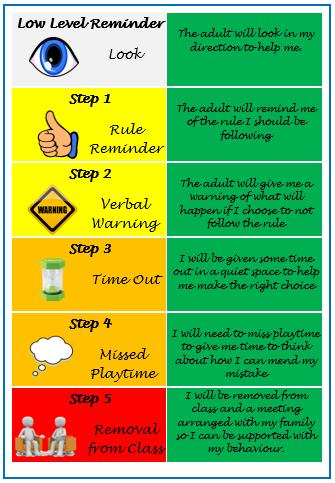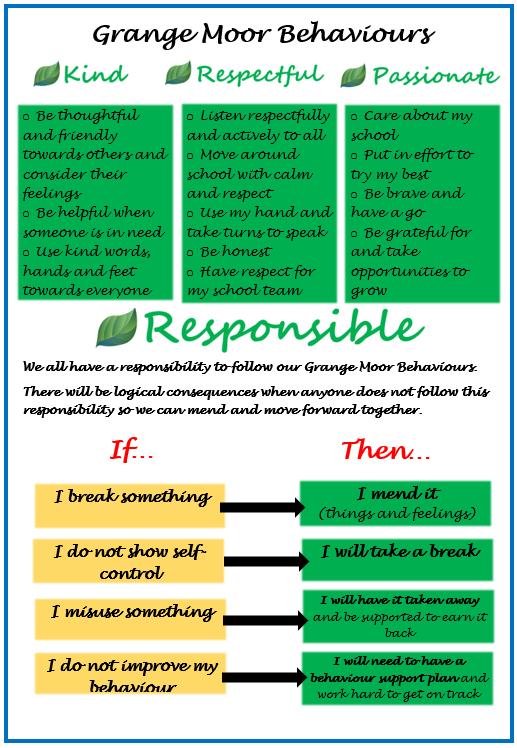

Behaviour Policy September 2024
The Staff and Governors are mindful of the responsibility of Section 175 of the Education Act 2002 which requires governing bodies to ‘exercise their functions with a view to safeguarding and promoting the welfare of children’
Rationale:
At Grange Moor Primary School, we aim to provide a safe and happy environment where both personal and emotional development, as well as physical and intellectual development are promoted and supported. Having both discipline and good learning behaviours are key to achievement and ensuring all pupils can reach their full potential.
Aims:

To ensure all children feel safe in an environment they can thrive in, we aim to:
• Develop within each child, a personal code of behaviour where consideration for others, sensitivity, truthfulness and integrity, are firmly valued, whatever the ability, sex, race or religion
• Actively promote Fundamental British Values throughout school.
• Promote positive behaviour management with systems of rewards, celebrations balanced with clear boundaries that support children to think and improve their behaviour.
• Praise and support each other to develop self-esteem and recognise good behaviours for learning
• Deal quickly and effectively, positively, sensitively and discreetly with any behaviour issues - keeping in mind the dignity and welfare of all concerned.
• Eradicate and deal quickly and effectively with bullying behaviours
• Encourage and help the children to take responsibility for their own behaviour and actions through developing a positive growth mindset.
The maintenance of positive behaviour and discipline within the school is the responsibility of all school staff and is outlined within the framework of this policy. It is important to us that children, parents and staff at Grange Moor Primary School work together, within our school values, to ensure that our school is a safe place where children are able to learn and teachers are able to teach.





Kind Respectful Passionate
Responsible

Our Grange Moor Behaviours – decided and agreed by children – are the main values that underpin this policy, our behaviour strategies and expectations.
Each class will discuss the school behaviours in an age-appropriate way as a foundation for discipline in the classroom and personalise how this is displayed and reinforced day to day.
School Rules and Expectations
These apply throughout all the school day, including before and after school, all playtimes including outside, lunch time and wet playtimes:
• Children should arrive at school on time and with appropriate equipment.
• Around all areas of the school, we expect children to move in an orderly fashion with due care and consideration for others and for school property. A quiet atmosphere and sense of purpose should be maintained. Children should be ready to learn as soon as they enter the school building.
• Children walk from the classroom and line up showing that they are ready to leave the building for play time. They walk to the designated exit and are let into the playground by the adult on duty. At the end of play time, the whistle is blown once for child to stop and be silent, then a second time for children to walk to their class line ready to be led back into school by their teacher. Children are expected to walk through the playground and remain walking in the school building.
• School uniform must be worn and equipment for school (PE kit, book bag, reading books, etc) should be present every day.
• Children speak to and interact with all members of the school community with respect and in accordance with the school values. Adults in school will interact with each other and with the children in a respectful way.
• Children raise their hand when wanting to contribute, share or ask a question in whole class learning sessions and assemblies. Although other agreed systems may be agreed with classes by their teacher to allow for development of teaching pedagogies around engagement.
• Individual Class Rules are negotiated to reflect the school values and expectations at the beginning of each school year and teachers plan time to support children to learn and understand these positively.
Whole School Reward System
As a school we take a positive approach to behaviour. The following rewards are used frequently throughout the school:
• Verbal praise
• Stickers
• Rewards in weekly celebration assemblies
• House Points with weekly house challenges linked to learning and behaviour leading to a half termly winning house
• Personalised whole class rewards agreed and established each year as part of transition
• Weekly House Reward Time every Friday
• Displaying work
• Informing parents – through phone calls, messages & directly speaking to on collection.
• Opportunity to tell and share with other staff eg the Head Teacher
Celebration Assemblies
Each week a Celebration assembly is held to which parents are invited. Each class teacher chooses 1 pupil to discuss and celebrate what is wonderful about them. Children are also invited to bring in certificates and badges from their out-of-school activities and share their accomplishments
How we discourage poor behaviour
All staff discourage poor behaviour in a variety of ways and are mindful of child/staff dignity and well-being when dealing with an issue. We encourage the use of low key cues to prevent the escalation of poor behaviour. It is expected that the following cues will be used frequently by adults working in the classroom:
• Tactical ignoring
• Praise and positive reinforcement
• Looking in the direction of the pupil
• Moving closer to the pupil
• Use of distraction
• Reminding the whole class of the rule or expected behaviour
• Adults will model the desired behaviour eg an ETA may sit with a child to show them what is expected.
In addition to our policy of rewards and stepped boundaries, it is also important that we note changes in a child’s behaviour. The changes may take a variety of forms. If we are concerned about a child it is important that we:
• Liaise with the parent/carer as soon as possible
• Inform the Head Teacher
• Inform the Out of School Club Leader if appropriate
• Monitor and record details of the child’s behaviour
There may also be implications where the Anti-Bullying Policy links to the school Safeguarding Procedures and practice.
When low key strategies have not worked effectively and undesirable behaviour continues, there are set classroom boundaries that take place in a specific order to ensure all parties involved know what will happen if rules are not followed.
Classroom Sanctions
Low Level Cues: Looking in direction of child.
Step 1: Rule Reminder. Reminder of the rule that should be being followed. In a supportive and positive way.
Step 2: Verbal warning. A clear and firm warning of why the rule needs to be followed.
Step 3: Time Out. Given a short few minutes time out in a quite space, to be calm and have a 1:1 discussion
Step 4: Missed play time. Some of Playtime with staff member for reflection and support. Parents will be informed. Step 5 (or dangerous behaviour): Removal from class. Time out of class, with Headteacher so everyone can be safe and support given to address the behaviour. Meeting with parents arranged to create a personalised plan for moving forwards.
Those children who reach step 4, will be recorded each week as a log so this can be monitored and intervention put in place proactively if this occurs regularly. Each week, children will have a discussion with SLT during Friday Reward
Time to help them understand their behaviour, know clearly what expectations are and be supported for the week ahead in a restorative way.
Behaviour Plans
In the case of repetition of steps 4-5 it will be acknowledged that additional support for behaviour is needed. A meeting with family will be set up and a personalised plan created to monitor and support behaviour. The plan will be led by the Headteacher, with regular reviews to keep families informed.
Exclusion
When previous procedures are not effective further sanctions may be needed. A child may be removed from their class for a fixed time period Also, following an extreme incident, for example very high levels disruption or danger to others, then the child will be removed from their class and supported by a member of staff. A formal meeting with a parent must be arranged as soon as possible, at the convenience of the Headteacher. They will then be supervised outside the classroom with an ETA or in another class including unstructured times. In exceptional or repeated circumstances, verbal or physical abuse or violence will result in exclusion from school.
Break Times
The 5 steps will be used in the same way during playtimes to ensure consistency in the management of behaviour. Step 3 time out will be with an adult outside. Step 4 will be supported by Headteacher/Teacher so that the child can have some time away from the playtime and support to get back on track. Dangerous behaviour or incidents of purposefully hurting other children will be treated at Step 4 so that intervention can happen and the safety of everyone is ensured.
Monitoring and Review
1. Every week, staff briefings will have time allotted to discuss behaviour of specific children, alongside H&S and Safeguarding.
2. Each term an opportunity will be given to staff to discuss issues arising from the operation of the policy.
3. The Head Teacher will monitor the policy in practice.
4. The policy will be reviewed on an annual basis.
5. A report will be given to the Governing Body termly


